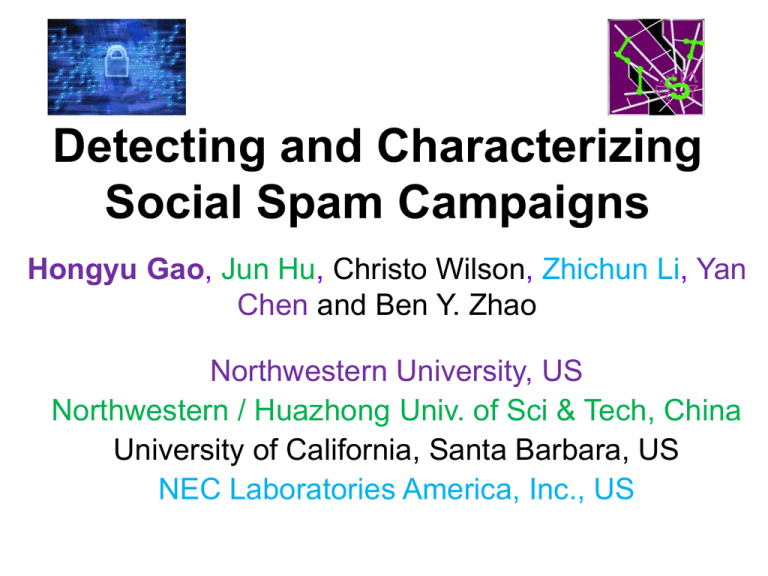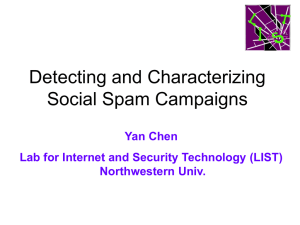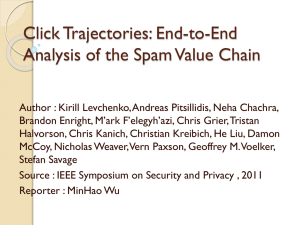Detecting and Characterizing Social Spam Campaigns
advertisement

Detecting and Characterizing Social Spam Campaigns Hongyu Gao, Jun Hu, Christo Wilson, Zhichun Li, Yan Chen and Ben Y. Zhao Northwestern University, US Northwestern / Huazhong Univ. of Sci & Tech, China University of California, Santa Barbara, US NEC Laboratories America, Inc., US Background 2 Benign post1 … … Benign post2 Benign post3 Benign post1 Benign post2 … … … Benign post1 Benign post2 … … … Benign post3 … Benign post1 Benign post2 … … Benign post1 Benign post2 … … Benign post1 Benign post2 3 Secret admirer reveald. Go here to find out who … 4 Contributions • Conduct the largest scale experiment on Facebook to confirm spam campaigns. – 3.5M user profiles, 187M wall posts. • Uncover the attackers’ characteristics. – Mainly use compromised accounts. – Mostly conduct phishing attack. • Release the confirmed spam URLs, with posting times. – http://list.cs.northwestern.edu/socialnetworksecurity – http://current.cs.ucsb.edu/socialnets/ 5 Roadmap • Detection System Design • Validation • Malicious Activity Analysis • Conclusions 6 System Overview • Identify coordinated spam campaigns in Facebook. – Templates are used for spam generation. 7 Build Post Similarity Graph Go to evil.com! Check out funny.com – A node: an individual wall post – An edge: connect two “similar” wall posts 8 Wall Post Similarity Metric Spam wall post model: A textual description: hey see your love compatibility ! go here yourlovecalc . com A destination URL: (remove spaces) 9 Wall Post Similarity Metric • Condition 1: – Similar textual description. 14131193659701777830, Guess “Guess 996649753058124798, who whoyour ”, “uess secret who admirer 1893573314373873575, y”, 14741306959712195600, “essis?? who yo”, “ss who you”, Go “s 10922172988510136713, 4928375840175086076, who hereyour”, nevasubevd “ who your . blogs ”,5186308048176380985, 9812648544744602511, “who pot .your co ms”, (take “ho out yourspaces) se”, … …… Guess who secret admirer 996649753058124798, “Guess 14131193659701777830, whoyour ”, “uess who 1893573314373873575, y”, 14741306959712195600, “essis??” who yo”, “ss who you”, “s 10922172988510136713, 4928375840175086076, whoyes-crush your”, “who your(remove s”, 5186308048176380985, 9812648544744602511, “ho your se”, “o your sec”, … …… Visit: . com spaces) Establish an edge! 10 Wall Post Similarity Metric • Condition 2: – Same destination URL. secret admirer revealed. goto yourlovecalc . com (remove the spaces) hey see your love compatibility ! go here yourlovecalc . com (remove spaces) Establish an edge! 11 Extract Wall Post Campaigns • Intuition: A B B A B C C • Reduce the problem of identifying potential campaigns to identifying connected subgraphs. 12 Locate Spam Campaigns • Distributed: campaigns have many senders. • Bursty: campaigns send fast. Wall post campaign NO Distributed? Benign YES NO YES Malicious Bursty? Benign 13 Roadmap • Detection System Design • Validation • Malicious Activity Analysis • Conclusions 14 Validation • Dataset: – Leverage unauthenticated regional network. – Wall posts already crawled from prior study. – 187M wall posts in total, 3.5M recipients. – ~2M wall posts with URLs. • Detection result: – ~200K malicious wall posts (~10%). 15 Validation • Focused on detected URLs. • Adopted multiple validation steps: URL de-obfuscation Keyword matching 3rd party tools URL grouping Redirection analysis Manual confirmation 16 Validation • Step 1: Obfuscated URL – URLs embedded with obfuscation are malicious. – Reverse engineer URL obfuscation methods: • Replace ‘.’ with “dot” : 1lovecrush dot com • Insert white spaces : abbykywyty . blogs pot . co m 17 Validation • Step 2: Third-party tools – Use multiple tools, including: • McAfee SiteAdvisor • Google’s Safe Browsing API • Spamhaus • Wepawet (a drive-by-download analysis tool) •… 18 Validation • Step 3: Redirection analysis – Commonly used by the attackers to hide the malicious URLs. URL1 URLM 19 Experimental Evaluation Obfuscated URL 6.3% Blacklisted URL 28.0% Redirection Anslysis 27.9% Keyword matching 1.2% 32.5% URL grouping Manual confirmation 0.1% True Positives (ALL) False Positives 96.1% 3.9% The validation result. 20 Roadmap • Detection System Design • Validation • Malicious Activity Analysis • Conclusions 21 Malicious Activity Analysis • Spam URL Analysis • Spam Campaign Analysis • Malicious Account Analysis • Temporal Properties of Malicious Activity 22 Spam Campaign Topic Analysis • Identifying attackers’ social engineering tricks: Campaign Summarized wall post description Post # Crush Someone likes you 45088 Ringtone Invitation for free ringtones 22897 Love-calc Test the love compatibility 20623 … … … 23 Spam Campaign Goal Analysis Phishing #1: for money Phishing #2: for info • Categorize the attacks by attackers’ goals. 24 Malicious Account Analysis • Account behavioral analysis: Using application Receiving wall post Either Neither 33.9% 84.5% 89% 11% • Sampled manual analysis: Human conversation Unknown conversation No conversation 194 5 1 25 Malicious Account Analysis • Counting all wall posts, the curves for malicious and benign accounts converge. 26 Roadmap • Detection System Design • Validation • Malicious Activity Analysis • Conclusions 27 Conclusions • Conduct the largest scale spam detection and analysis on Facebook. – 3.5M user profiles, 187M wall posts. • Make interesting discoveries, including: – Over 70% of attacks are phishing attacks. – Compromised accounts are prevailing. 28 Thank you! Project webpage: http://list.cs.northwestern.edu/socialnetworksecurity http://current.cs.ucsb.edu/socialnets/ Spam URL release: http://dod.cs.northwestern.edu/imc10/URL_data.tar.gz 29 Bob’s Wall Bob Chuck From: Dave That movie was fun! From: Chuck Check out funny.com From: Chuck Go to evil.com! Go to out Check evil.com! funny.com That movie was fun! Dave 30 Benign post1 … … Benign post1 Benign post2 Benign post3 Malicious p1 Benign post2 … … … Benign post1 … … Benign post2 … … Benign post3 Malicious p1 … Benign post1 Benign post2 Malicious p1 Malicious p2 … … … … Benign post1 Benign post2 … … … … … Benign post1 Benign post2 Malicious p1 Malicious p2 31 Data Collection • Based on “wall” messages crawled from Facebook (crawling period: Apr. 09 ~ Jun. 09 and Sept. 09). • Leveraging unauthenticated regional networks, we recorded the crawled users’ profile, friend list, and interaction records going back to January 1, 2008. • 187M wall posts with 3.5M recipients are used in this study. 32 Filter posts without URLs • Assumption: All spam posts should contain some form of URL, since the attacker wants the recipient to go to some destination on the web. • Example (without URL): Kevin! Lol u look so good tonight!!! Filter out 33 Filter posts without URLs • Assumption: All spam posts should contain some form of URL, since the attacker wants the recipient to go to some destination on the web. • Example (with URL): Um maybe also this: http://community.livejournal.com/lemonadepoem/54654.html Guess who your secret admirer is?? Go here nevasubevd\t. blogs pot\t.\tco\tm (take out spaces) Further process 34 Extract Wall Post Clusters A sample wall post similarity graph and the corresponding clustering result (for illustrative purpose only) 35 Locate Malicious Clusters • (5, 1.5hr) is found to be a good (n, t) value. • Slightly modifying the value only have minor impact on the detection result. • A relaxed threshold of (4, 6hr) only result in 4% increase in the classified malicious cluster. 36 Experimental Validation • Step 5: URL grouping – Groups of URLs exhibit highly uniform features. Some have been confirmed as “malicious” previously. The rest are also considered as “malicious”. – Human assistance is involved in identifying such groups. • Step 6: Manual analysis – We leverage Google search engine to confirm the malice of URLs that appear many times in our trace. 37 URL Analysis • 3 different URL formats (with e.g.): – Link: <a href=“...”>http://2url.org/?67592</a> – Plain text: mynewcrsh.com – Obfuscated: nevasubevu . blogs pot . co m Type Total # # of URLs # of Wall Posts Avg # of Wall posts per URL 15,484 199,782 N/A Obfuscated 6.5% 25.3% 50.3 Plaintext 3.8% 6.7% 22.9 Hypertext link 89.7% 68.0% 9.8 38 URL Analysis • 4 different domain types (with e.g.): – Content sharing service: imageshack.us – URL shortening service: tinyurl.org – Blog service: blogspot.com – Other: yes-crush.com Type # of URLs # of Wall Posts ContentShare 2.8% 4.8% URL-short 0.7% 5.0% Blogs 55.6% 15.8% Other 40.9% 74.4% 39 Spam Campaign Temporal Analysis 40 Account Analysis • The CDF of interaction ratio. • Malicious accounts exhibit higher interaction ratio than benign ones. 41 Wall Post Hourly Distribution • The hourly distribution of benign posts is consistent with the diurnal pattern of human, while that of malicious posts is not. 42






